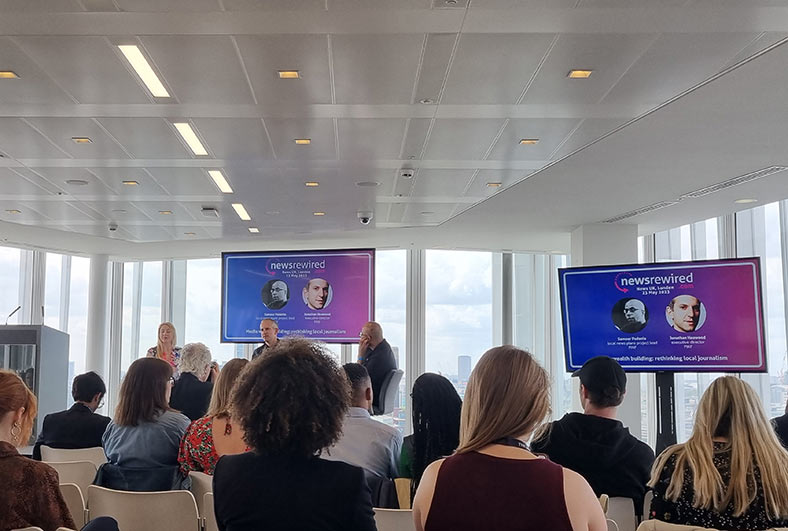Blog / Events / Journalists
Adapting to the current news climate: Advice from the Newsrewired conference

The news agenda is constantly changing. For many, this variety of issues and topics to report on is the reason they get into journalism. However, constant change is also taking place within the media industry itself.
More people are avoiding the news. The economic situation is making people less likely to subscribe to media outlets. AI poses a potential threat to how reporters and editors do their job. All these recent developments are impacting journalists. So how should journalists change and adapt? At the Newsrewired conference last week in London, all these areas were addressed along with other solutions and advice on dealing with the ever-changing media landscape.
Countering news avoidance
There is a growing trend in the UK around news avoidance, especially amongst the younger demographic. Edward Roussel highlighted in the opening speech of the day that 46% of Brits are avoiding the news and that this has doubled in the last five years – perhaps caused by the proportion of negative headlines that has surged between 2000 and 2019.
The good news is that there are ways to counter this. Mark St Andrew, head of ThinkIns at Tortoise Media, spoke about their ‘slow news’ approach, which aims to take more time to fully explain the story. Shirish Kulkani, a journalism innovation and inclusion consultant, said that news should be realigning itself to give context and sense making. People need to know what has come before and what is to come.
Engaging subscribers
The ongoing cost-of-living crisis is having a big impact on the journalism industry with less people willing to buy a paper and less likely to take out a subscription. Plus, with so many media outlets to choose from now, it makes it harder than ever to keep subscribers interested. According to Abdullah Ahmed, director of subscriber retention at Times Media, the cost of acquiring a subscriber can be three to four times that of retaining one.
Anna Lorch, head of consumer product marketing and subscription at the Washington Post, said that people are only willing to pay for something that is relevant to them. Therefore, being data informed and using data analytics to really understand your audience and what they are interested in can help inform your retention strategy.
Benefits of live blogging
There are so many ways to tell a story now. From short-form video to longreads, a journalist has many tools at their disposal to cover the news. One format that does well with audiences, and has apparently been around since the 1920s, is live blogging.
Alexandra Föderl-Schmid, deputy editor-in-chief of Süddeutsche Zeitung, spoke of its benefits for breaking news as it creates an up-to-date, convenient, user-friendly flow of news. However, it can also be important for readers to know they will get live up-to-the-minute information for regular events like the weekly football matches or foreseeable events like Oktoberfest. It helps to engage new users as they can ask questions and make comments in real-time, and has been successful for Alexandra’s title as seven of their ten most read pieces so far this year are live blogs.
Reskilling for AI
There has been a lot of talk recently about the impact of AI, not just on the media industry but across all workforces. The panel were largely positive about what AI could bring to journalism. Tshepo Tshabalala, manager at JournalismAI, pointed out that it has been a part of many newsrooms for a while with Eleanor Warnock, deputy editor at Sifted, saying that Grammarly is a well-used AI tool at her organisation.
AI can assist journalists to do their jobs and help cut out a lot of the boring tasks, like podcast editing or finding images. Jane Barrett, global editor for media news strategy at Reuters, added that it might require a culture change in the newsroom with reskilling and training on what journalists can do and can’t do with AI. Having already been through a digital transformation in newsrooms ten or so years ago, this should be faster as there is a more personalised existential threat rather than a commercial one.
Local people writing local news
Trust in the British media is not particularly high at the moment. However, local news tends to fair a lot better. According to Jonathan Heawood, founder of the Public Interest News Foundation, local media that is locally-owned does even better with a net positive trust score. If it’s not locally-owned, however, it still has a net negative trust score.
This is partly due to people wanting the money to stay local when it comes to news organisations, rather than being fed back into a larger corporation. Taking control away from the centre and giving it out to communities at a local level can help bridge the disconnect they might feel. They will know it’s local people writing local news and that what is being talked about is relevant to them and their lives. Ventures like Social Spider’s community newspapers are a good example of this.